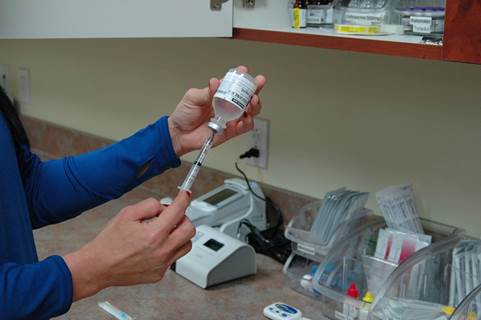How Can Pharmacists Improve Flu Vaccination Rates in Patients with COPD?
Although individuals living with chronic obstructive pulmonary disease (COPD) have a significantly higher risk of morbidity and mortality if they acquire influenza, most do not receive the annual influenza vaccination. To improve vaccination rates among this group, pharmacists must prioritize the promotion of the flu vaccination by maintaining an awareness of the characteristics present in those who generally do not receive vaccinations.
 Despite best attempts of Healthy People 2010 to achieve a 60% coverage rate for high-risk adults, less than 40% of individuals with COPD were vaccinated. Although Healthy People 2020’s goal has increased to 90% coverage, “vaccination rates among these patients rarely exceed 50%.” Concerning is the fact that unvaccinated patients with COPD have substantially higher risks of experiencing “exacerbations, greater pulmonary function impairment, reduced quality of life, and economic burden if they develop the flu.”
Despite best attempts of Healthy People 2010 to achieve a 60% coverage rate for high-risk adults, less than 40% of individuals with COPD were vaccinated. Although Healthy People 2020’s goal has increased to 90% coverage, “vaccination rates among these patients rarely exceed 50%.” Concerning is the fact that unvaccinated patients with COPD have substantially higher risks of experiencing “exacerbations, greater pulmonary function impairment, reduced quality of life, and economic burden if they develop the flu.”
Researchers from the University of New Mexico have recently published a study, which appeared in the journal titled, “Research in Social and Administrative Pharmacy.” The study analyzed COPD patients who responded to the 2012 Behavioral Risk Factor Surveillance System in order to determine influenza vaccination rates. This data was then used “to identify predisposing, enabling, and need factors that influence the decision to be vaccinated.”
The findings revealed that 53% of respondents had been vaccinated. Data also suggested that the older the individual, the more likely they were to have been vaccinated. Patients who were never married had a significantly lower likelihood of being vaccinated in comparison to those who were married, divorced, widowed or separated. Additionally, participants who were current smokers or who had not seen a healthcare provider for a checkup in a year or more were also less likely to be vaccinated.
It was also discovered that unemployed individuals, as well as those who received care from a primary physician or were insured also had a higher likelihood of vaccination. Increased rates were associated with the prevalence “of a pharmacist immunizer on the staff of centers that serve the medically underserved.”
Although certain individuals may be less likely to receive the flu vaccination, sometimes a simple encouragement can make all the difference. Pharmacists can make an impact by screening for patients with COPD, determining which factors they may have that are associated poor vaccination rates, and providing encouragement to patients who are less likely to receive the vaccination.

